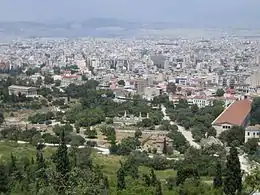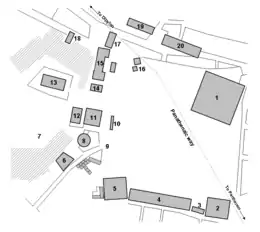Ancient Agora of Athens
The ancient Agora of Athens (also called the Classical Agora) is the best-known example of an ancient Greek agora, located to the northwest of the Acropolis and bounded on the south by the hill of the Areopagus and on the west by the hill known as the Agoraios Kolonos, also called Market Hill.[1] The Agora's initial use was for a commercial, assembly, or residential gathering place.[2]
Αρχαία Αγορά της Αθήνας | |
 Central Athens | |
| Alternative name | Forum of Athens |
|---|---|
| Location | Greece |
| Region | Attica |
| Coordinates | 37°58′30″N 23°43′21″E |
| History | |
| Material | Marble |
| Founded | 6th century BC |
| Periods | Classical era |
| Cultures | Ancient Greece |
| Site notes | |
| Excavation dates | 1931 until today |
| Archaeologists | American School of Classical Studies at Athens |
| Condition | Ruined |
| Ownership | Public property |
| Management | Minister for Culture |
| Public access | Yes |

Buildings and structures of the classical agora

- Peristyle Court
- Mint
- South-east Fountain House
- South Stoa I
- Aiakeion
- Strategeion
- Agoraios Kolonos
- Tholos
- Boundary stone
- Monument of the Eponymous Heroes
- Metroon (Old Bouleuterion)
- New Bouleuterion
- Temple of Hephaestus (Hephaestion)
- Temple of Apollo Patroos
- Stoa of Zeus
- Altar of the Twelve Gods
- Stoa Basileios (Royal stoa)
- Temple of Aphrodite Urania
- Stoa Poikile
Other notable monuments


A number of other notable monuments were added to the agora. Some of these included:
- The Middle stoa which was the most extensive monument built during the 100s BCE[3]
- A small Roman temple was added in front of the Middle stoa.
- An Altar of Zeus Agoraios was added just to the east of the Monument to the Eponymous Heroes.[4]
- The Temple of Ares, dedicated to Ares, the god of war, was added in the north half agora, just south of the Altar of the Twelve Gods.[5]
- The Odeon of Agrippa and accompanying gymnasium were added in the centre of the agora.[6]
- The substantial Stoa of Attalos was built along the eastern edge of the agora.[7]
- A collection of buildings were added to the south-east corner: the East stoa, the Library of Pantainos, the Nymphaeum and a temple.
- The Library of Pantainos was more than just a library, the west and north wings were series of rooms that were used for other purposes other than storing books. With the construction of the Library of Pantainos, the official entrance into the agora was now between the Library and the Stoa of Attalos.[8]
- There is evidence of a Synagogue in the Agora of Athens in the 3rd century.
- A statue of the Roman emperor Hadrian was located near the metroon.[9]
- The Temple of Zeus Phratrios and Athena Phratria dated to the 300s BCE and is located near the Temple of Apollo Patroos.[10]
- The south end of what is believed to be a Basilica has been uncovered near Hadrian Street and is dated to the mid 100s CE[11]
- The Monopteros was located south of the Basilica and also dated to the mid 100s CE It had no walls, was a dome supported by columns and was about 8 meters in diameter.[12]
- The Bema was a speakers platform and was located near the Stoa of Attalos.[13]
Excavations
The ancient Athenian agora has been excavated by the American School of Classical Studies at Athens since 1931 under the direction of T. Leslie Shear, Sr. They continue to the present day, now under the direction of John McK Camp.[14]
After the initial phase of excavation, in the 1950s the Hellenistic Stoa of Attalos was reconstructed on the east side of the agora, and today it serves as a museum and as storage and office space for the excavation team.[15]
A virtual reconstruction of the Ancient Agora of Athens has been produced through a collaboration of the American School of Classical Studies at Athens and the Foundation of the Hellenic World, which had various output (3d video, VR real-time dom performance, Google Earth 3d models).[16]
Flora
Evidence of planting was discovered during the excavations and in January 4, 1954 the first oak and laurel trees were planted around the Altar of Zeus by Queen Frederika and King Paul as part of the efforts to restore the site with plants that would have been found there in antiquity.[17]
Museum of the Ancient Agora
The museum is housed in the Stoa of Attalos, and its exhibits are connected with the Athenian democracy. The collection of the museum includes clay, bronze and glass objects, sculptures, coins and inscriptions from the 7th to the 5th century BC, as well as pottery of the Byzantine period and the Turkish occupation. The exhibition within the museum contains work of art which describes the private and public life in ancient Athens. In 2012, new sculpture exhibition was added to the museum which includes portraits from Athenian Agora excavation. The new exhibition revolves around portraits of idealized gods, officially honored people of the city, wealthy Roman citizens of the 1st and 2nd century AD, 3rd-century citizens and finally on work of art from private art schools of late antiquity.[18]
 Media related to Museum of the Ancient Agora at Wikimedia Commons
Media related to Museum of the Ancient Agora at Wikimedia Commons
References
- R.E. Wycherley, Literary and Epigraphical Testimonia (Athenian Agora) (American School of Classical Studies, 1957), p. 27.
- Sakoulas, Thomas. "The Agora of Athens". ancient-greece.org. Retrieved 4 November 2017.
- Camp, The Athenian Agora: Site Guide, p. 168.
- Camp, The Athenian Agora: Site Guide, p. 65.
- Camp, The Athenian Agora: Site Guide, p. 110.
- Camp, The Athenian Agora: Site Guide, p. 114.
- Camp, The Athenian Agora: Site Guide, p. 123.
- A., Thompson, Homer (1972). The Agora of Athens : the history, shape, and uses of an ancient city center. Wycherley, R.E. (Richard Ernest). Princeton, NJ: American School of Classical Studies at Athens. ISBN 978-0876612149. OCLC 554992.
- Camp, The Athenian Agora: Site Guide, p. 63.
- Camp, The Athenian Agora: Site Guide, p. 73.
- Camp, The Athenian Agora: Site Guide, p. 93.
- Camp, The Athenian Agora: Site Guide, p. 118.
- Camp, The Athenian Agora: Site Guide, p. 122.
- Sideris A., "A Virtual Cradle for Democracy: Reconstructing the Ancient Agora of Athens", Proceedings of the International SEEArchWeb Conference, Thessaloniki, September 2006.
- Garden Lore of Ancient Athens. American School of Classical Studies. p. 4.
- "Ministry of Culture and Sports | Museum of the Ancient Agora". odysseus.culture.gr. Retrieved 29 September 2017.
Further reading
- Camp, J. (2010). The Athenian Agora Site Guide. 5th ed. Princeton, NJ: American School of Classical Studies.
- Dickenson, Christopher P. (2015). "Pausanias and the "Archaic Agora" at Athens." Hesperia: The Journal of the American School of Classical Studies at Athens 84.4: 723–770.
- Dickenson, Christopher P. and Onno M. van Nijf ed. (2013). Public Space in the Post-Classical City: Proceedings of a One Day Colloquium held at Fransum, 23rd July 2007. Caeculus, 7. Leuven: Peeters.
- Gawlinski, L. (2007). "The Athenian Calendar of Sacrifices: A New Fragment from the Athenian Agora." Hesperia 76:37–55.
- Harris, Edward Monroe (2014). "Wife, Household, and Marketplace." In Women Who Count in Greek History. Edited by Umberto Bultrighini, Elisabetta Dimauro. Lanciano: Carabba.
- Lang, M. (1994). Life, Death, and Litigation in the Athenian Agora. Agora Picturebook 23. Princeton, NJ: American School of Classical Studies at Athens.
- Lang, M. (2004). The Athenian Citizen: Democracy in the Athenian Agora. Rev. ed. Agora Picturebook 4. Princeton, NJ: American School of Classical Studies at Athens.
- MacKinnon, Michael (2014). "Animals, Economics, and Culture in the Athenian Agora: Comparative Zooarchaeological Investigations." Hesperia: The Journal of the American School of Classical Studies at Athens 83.2: 189–255.
- Thompson, D.B. (1971). The Athenian Agora: An Ancient Shopping Center. Agora Picturebook 12. Princeton, NJ: American School of Classical Studies at Athens.
- Wycherley, R.E. (1973). The Athenian Agora. Vol. 3, Literary and Epigraphical Testimonia. Princeton, NJ: American School of Classical Studies.
External links
| Wikimedia Commons has media related to Ancient Agora of Athens. |
| Library resources about Athenian Agora |
- Hellenic Ministry of Culture: The Ancient Agora of Athens – official site with a schedule of its opening hours, tickets and contact information.
- Agora Excavations – American School of Classical Studies Agora excavation project.
- Map of the Agora of Athens in Socrates and Plato's time
- Agora of Athens in 421 BC
- The Athenian Agora: A Short Guide in Color
- The Athenian Agora. A Guide to the Excavation and Museum
- Reconstruction of the Athenian Agora in Google Earth
- Ministry of Culture: The Museum
- www.athensinfoguide.com The Museum
- Agora of Athens: photo album and description
- Agora of Athens photos

